华为AP2050DN-E接入点详版彩页
- 格式:pdf
- 大小:972.46 KB
- 文档页数:14

华为
敏捷分布式WIFI解决方案详版彩页
产品概述............................................................................................................................................ //信息化已经融入教育、商业、企业等各行各业,Wi-Fi技术也逐渐得到越来越广泛的应用。
但是传统的放装
企业业务产品介绍营销资料
版权所有 © 华为技术有限公司 2016。
保留一切权利。
非经华为技术有限公司书面同意,任何单位和个人不得擅自摘抄、复制本手册内容的部分或全部,并不得以任何形式传播。
商标声明
HUAWEI 华为是华为技术有限公司的商标或者注册商标。
在本手册中以及本手册描述的产品中,出现的其他商标、产品名称、服务名称以及公司名称,由其各自的所有人拥有。
免责声明
本文档可能含有预测信息,包括但不限于有关未来的财务、运营、产品
系列、新技术等信息。
由于实践中存在很多不确定因素,可能导致实际
结果与预测信息有很大的差别。
因此,本文档信息仅供参考,不构成任
何要约或承诺。
华为可能不经通知修改上述信息,恕不另行通知。

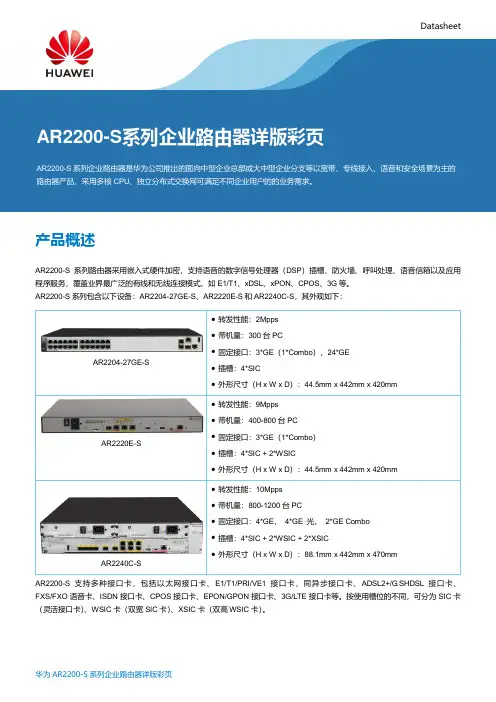
Datasheet产品概述AR2200-S系列路由器采用嵌入式硬件加密,支持语音的数字信号处理器(DSP)插槽、防火墙、呼叫处理、语音信箱以及应用程序服务,覆盖业界最广泛的有线和无线连接模式,如E1/T1、xDSL、xPON、CPOS、3G等。
AR2200-S系列包含以下设备:AR2204-27GE-S、AR2220E-S和AR2240C-S,其外观如下:AR2204-27GE-SAR2220E-SAR2240C-SAR2200-S支持多种接口卡,包括以太网接口卡、E1/T1/PRI/VE1接口卡、同异步接口卡、ADSL2+/G.SHDSL接口卡、FXS/FXO语音卡、ISDN接口卡、CPOS接口卡、EPON/GPON接口卡、3G/LTE接口卡等。
按使用槽位的不同,可分为SIC卡(灵活接口卡)、WSIC卡(双宽SIC卡)、XSIC卡(双高WSIC卡)。
关键特性及价值第3代AR,性能领先AR2200-S系列企业路由器采用多核CPU和无阻塞交换架构,产品性能业界领先,充分满足企业及分支机构网络未来多元化扩展、不断增长的业务需求。
●使用多核CPU,提高数据、语音的并发处理能力,为大容量业务的全方位部署创造条件●无阻塞交换,单槽位总线带宽最大可达10Gbps,业务转发无瓶颈●协议管理、业务处理、数据交换独立分布处理,性能更高,业务更可靠●路由交换一体化,跨板卡交换效率高,配置维护灵活简单●板卡热插拔,电源、风扇等关键硬件冗余设计,保证业务安全稳定双模网络,灵活接入1) 移动模式2) 固定模式多业务合1,融合开放AR2200-S支持路由、交换、3G、语音、安全等功能特性,实现业务多合一。
1) 开放业务平台(OSP)通过OSP与主流第三方IT系统集成和对接,为企业客户实现统一通信的业务体验,使客户、代理商、第三方和厂家都可以是开发者和使用者,真正实现业务价值链的共赢。
●快速集成与定制业务,满足用户个性化需求●深度融合各类业务,无需部署专门服务器,节省投资,易于管理●与云侧业务实时刷新和同步,本地业务由本地处理,提高质量和效率2) 丰富语音体验集成多种语音功能,利用数据网络满足企业语音通话需求,为企业提供灵活高效的沟通手段。

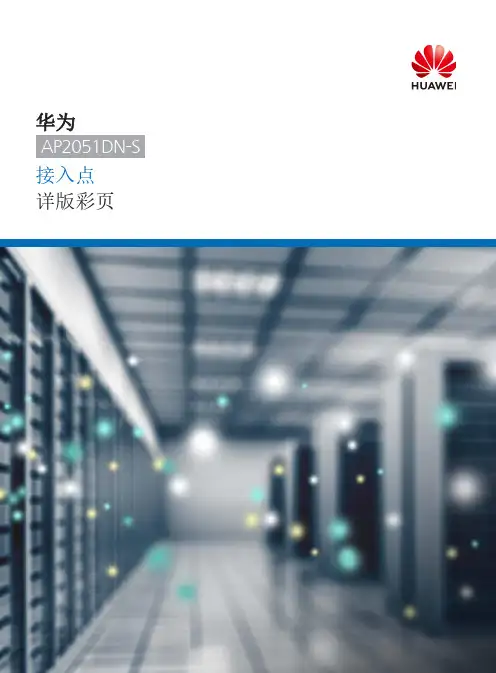
华为
接入点详版彩页
............................................................................................................................................ //
面板安装方式桌面安装方式
10
服务与支持
华为WLAN规划工具拥有业界最专业的仿真平台,提供专业的网络设计、优化服务,凭借
的网络规划优化经验、专家资源、先进的平台优势,助力您成功地规划、建设、运营无线网络。
合理的部署和优化网络可以提高网络的性能,可用性和安全性,同时降低投资成本和风险。
更多信息
版权所有© 华为技术有限公司2017。
保留一切权利。
非经本公司书面许可,任何单位和个人不得擅自摘抄、复制本文档内容的部分或全部,并不得以任何形式传播。
商标声明
和其他华为商标均为华为技术有限公司的商标。
本文档提及的其他所有商标或注册商标,由各自的所有人拥有。
免责声明
本文档可能含有预测信息,包括但不限千有关未来的财务、运营、产品系列、新技术等信息。
由于实践中存在很多不确定因素,可能导致实际结果与预测信患有很大的差别。
因此,本文档信息仅供参考,不构成任何要约或承诺。
华为可能不经通知修改上述信息,恕不另行通知。
华为技术有限公司深圳市龙岗区坂田华为基地
邮编:518129电话: +8675528780808
www.huawei.
com。

Eudemon1000E防火墙Eudemon1000E系列产品彩页华为技术有限公司<产品概述>Eudemon1000E系列产品是华为公司针对大流量安全业务需求的应用,推出的新一代多功能安全网关,可广泛应用于运营商、政府、金融、能源、高校等大型机构的网络,在高性能、高可靠性、高可扩展性、高可维护性四个方面为用户提供了技术领先的解决方案。
全新的多核硬件架构设计,成熟可靠的VRP软件平台,结合硬件级和软件级的可靠性支持,保障用户的网络不会受到业务中断的影响;开放的系统架构可支持对多种物理接口和软件功能的扩展,可以有效保障用户的前期投入,不断的为用户提升产品价值;提供多种管理和维护方式,既可以简便有效的管理设备,又可以实现问题和故障的快速定位,使用户的维护工作变得简单轻松。
同时,Eudemon1000E系列产品将GTP协议安全防护功能通过模块的方式融合到产品中来,使得Eudemon1000E系列安全网关可以解决GTP协议在传输的过程中遇到的安全风险,为运营商用户提供有效的GTP协议安全防护的解决方案。
<产品系列>Eudemon1000E-U6 Eudemon1000E-U5Eudemon1000E-U3 Eudemon1000E-U2<产品特点>网络安全特性全面保障用户不断增长的业务流量Eudemon1000E系列安全网关采用多核并行处理技术,最大可支持数十条线程并行处理,产品在性能上有了质的飞跃,三大主要性能指标在业界处于领先位置,为用户带来超高的性能体验,尤其是作为防火墙最关键的性能指标“每秒新建连接数”,达到了惊人的每秒15万条,在业界同类产品中处于绝对的领先,能在短时间内为用户的网络访问建立大量的连接,提供网络的高速转发和低延迟,同时,也可以有效的应对网络中产生的大量突发流量和网络攻击流量。
可满足多种高速转发的网络应用的要求,充分满足用户网络对带宽高速增长的需要。

Huawei Access Points DatasheetMU-MIMOThe AP2051DN and AP2051DN-E support MU-MIMO technology and can send data to multiple STAs at the same time (currently, most 802.11n/11ac Wave 1 APs can only send data to one STA simultaneously). The technology marks the start of the 802.11ac Wave 2 era.1-meter Bluetooth location (supported by the AP2051DN-E)The AP2051DN-E supports built-in Bluetooth. In compliance with BLE4.1, the AP2051DN-E can work with eSight to achieve precise Bluetooth location.PoE OUT power supply (supported by the AP2051DN-E)The AP2051DN-E supports PoE OUT and can supply power to STAs such as IP phones (providing that the AP uses 802.3at or DCpower supply).Cloud-based managementHuawei Cloud Managed Network (CMN) Solution consists of the cloud management platform and a full range of cloud managed network devices. The cloud management platform provides various functions including management of APs, tenants, applications, and licenses, network planning and optimization, device monitoring, network service configuration, and value-added services.GE accessThe APs support the 80-MHz bandwidth mode. Frequency bandwidth increase brings extended channels and more sub-carriers for data transmission, and a 2.16-fold rate increase. Support for High Quadrature Amplitude Modulation (HQAM) at 256-QAM increases the 5 GHz radio rate to 867 Mbit/s and the AP rate to 1.267 Gbit/s.High Density Boost technologyHuawei uses the following technologies to address challenges in high-density scenarios, including access problems, data congestion, and poor roaming experience:•SmartRadio for air interface optimizationˉ Load balancing during smart roaming: The load balancing algorithm can work during smart roaming for load balancing detection among APs on the network after STA roaming to adjust the STA load on each AP, improving network stability.ˉ Intelligent DFA technology: The dynamic frequency assignment (DFA) algorithm is used to automatically detect adjacent-channel and co-channel interference, and identify any 2.4 GHz redundant radio. Through automatic inter-AP negotiation, the redundant radio is automatically switched to another mode (dual-5G AP models support 2.4G-to-5G switchover) or is disabled to reduce 2.4 GHz co-channel interference and increase the system capacity.ˉ Intelligent conflict optimization technology: The dynamic enhanced distributed channel access (EDCA) and airtime scheduling algorithms are used to schedule the channel occupation time and service priority of each user. This ensures that each user isassigned relatively equal time for using channel resources and user services are scheduled in an orderly manner, improving service processing efficiency and user experience.•Air interface performance optimizationˉIn high-density scenarios where many users access the network, increased number of low-rate STAs consumes more resources on the air interface reduces the AP capacity, and lowers user experience. Therefore, Huawei APs will check the signal strength of STAs during access and rejects access from weak-signal STAs. At the same time, the APs monitor the rate of online STAs in real time and forcibly disconnect low-rate STAs so that the STAs can reassociate with APs that have stronger signals. The terminal access control technology can increase air interface use efficiency and allow access from more users.•5G-prior access (Band steering)ˉThe APs support both 2.4G and 5G frequency bands. The 5G-prior access function enables an AP to steer STAs to the 5 GHz frequency band first, which reduces load and interference on the 2.4 GHz frequency band, improving the user experience.Wired and wireless dual security guaranteeTo ensure data security, Huawei APs integrate wired and wireless security measures and provide comprehensive security protection.•Authentication and encryption for wireless accessˉThe APs support WEP, WPA/WPA2–PSK, WPA/WPA2–PPSK, WPA/WPA2–802.1X, and WAPI authentication/encryption modes to ensure security of the wireless network. The authentication mechanism is used to authenticate user identities so that onlyauthorized users can access network resources. The encryption mechanism is used to encrypt data transmitted over wireless links to ensure that the data can only be received and parsed by expected users.•Analysis on non-Wi-Fi interference sourcesˉHuawei APs can analyze the spectrum of non-Wi-Fi interference sources and identify them, including baby monitors, Bluetooth devices, digital cordless phones (at 2.4 GHz frequency band only), wireless audio transmitters (at both the 2.4 GHz and 5 GHzfrequency bands), wireless game controllers, and microwave ovens. Coupled with Huawei eSight, the precise locations of theinterference sources can be detected, and the spectrum of them displayed, enabling the administrator to remove the interference in a timely manner.•Rogue device monitoringˉHuawei APs support WIDS/WIPS, and can monitor, identify, defend, counter, and perform refined management on the rogue devices, to provide security guarantees for air interface environment and wireless data transmission.•AP access authentication and encryptionˉThe AP access control ensures validity of APs. The CAPWAP link protection and DTLS encryption provide security assurance, improving data transmission security between the AP and the AC.Automatic radio calibrationAutomatic radio calibration allows an AP to collect signal strength and channel parameters of surrounding APs and generate AP topology according to the collected data. Based on interference from authorized APs, rogue APs, and non-Wi-Fi interference sources, each AP automatically adjusts its transmit power and working channel to make the network operate at the optimal performance. In this way, network reliability and user experience are improved.Automatic application identificationHuawei APs support smart application control technology and can implement visualized control on Layer 4 to Layer 7 applications.•Traffic identificationˉCoupled with Huawei ACs, the APs can identify over 1600 common applications in various office scenarios. Based on the identification results, policy control can be implemented on user services, including priority adjustment, scheduling, blocking, and rate limiting to ensure efficient bandwidth resource use and improve quality of key services.•Traffic statistics collectionˉTraffic statistics of each application can be collected globally, by SSID, or by user, enabling the network administrator to know application use status on the network. The network administrator or operator can implement visualized control on serviceapplications on smart terminals to enhance security and ensure effective bandwidth control.Huawei AP2051DN & AP2051DN-EAccess Points Datasheet 04 Basic Specifications......................................................................................................................... //Hardware specificationsItem DescriptionTechnical specifications Dimensions (H x W x D) 32.5 mm × 150 mm × 86 mmWeight 0.25 kgInterface typeUplink: 1 x GEDownlink: 4 x GE2 x Pass-through RJ45 port1 x USB portBuilt-in Bluetooth AP2051DN-E: BLE4.1LED indicator Indicates the power-on, startup, running, alarm, and fault status of the system.Power specifications Power inputPower adapter: 45.6 V to 57 VPoE power supply: in compliance with IEEE 802.3af/atPoE OUTAP2051DN-E: MAX 13.6W (802.3at-compliant, 48 V DC, supported only by GE4)● A 40-meter Cat5e Ethernet cable can be used to supply power to an802.3af-compliant device.●The PoE out and USB functions cannot be used simultaneously.Maximum powerconsumptionAP2051DN: 11.5 W (excluding the output power of the USB port)AP2051DN-E: 11.5 W (excluding the output power of the USB port and PoE_OUTport)The actual maximum power consumption depends on local laws and regulations.Environmental specifications Operating temperature 0°C to 40°CStorage temperature–40°C to +70°COperating humidity 5% to 95% (non-condensing) Altitude –60 m to +5000 m Atmospheric pressure 53 kPa to 106 kPaNOTENOTEHardware specificationsItem DescriptionRadio specificationsAntenna type Built-in dual-band smart antennasGain2.4G: 3 dB5G: 4 dBGain involves the physical gain and SINR enhancement of smart antennas. Maximum number ofSSIDs for each radio≤ 16Maximum number ofusers≤ 256The actual number of users varies according to the environment.Maximum transmitpower2.4G: 23 dBm (combined power)5G: 23 dBm (combined power)The actual transmit power depends on local laws and regulations. Power increment 1 dBmReceiver sensitivity2.4 GHz 802.11b: -99 dBm @ 1 Mbit/s -91 dBm @ 11 Mbit/s2.4 GHz 802.11g: -93 dBm @ 6 Mbit/s -78 dBm @ 54 Mbit/s2.4 GHz 802.11n (HT20): -93 dBm @ MCS0 -72 dBm @ MCS155 GHz 802.11a: -93 dBm @6 Mbit/s -77 dBm @ 54 Mbit/s5 GHz 802.11n (HT20): -92 dBm @ MCS0 -72 dBm @ MCS155 GHz 802.11n (HT40): -89 dBm @ MCS0 -70 dBm @ MCS155 GHz 802.11ac (VHT20): -92 dBm @ MCS0NSS1 -71 dBm @ MCS8NSS25 GHz 802.11ac (VHT40): -90 dBm @ MCS0NSS1 -63 dBm @ MCS9NSS25 GHz 802.11ac (VHT80): -86 dBm @ MCS0NSS1 -60 dBm @ MCS9NSS2NOTENOTENOTEBasic Specifications......................................................................................................................... //Software s pecificationsFat/Fit AP modeItem DescriptionWLAN features Compliance with IEEE 802.11a/b/g/n/ac/ac Wave 2Maximum rate: up to 1.267 Gbit/sMaximum ratio combining (MRC)Space time block code (STBC)Cyclic Delay Diversity (CDD)/Cyclic Shift Diversity (CSD)BeamformingMU-MIMOLow-density parity-check (LDPC)Maximum-likelihood detection (MLD)Frame aggregation, including A-MPDU (Tx/Rx) and A-MSDU (Tx/Rx)802.11 dynamic frequency selection (DFS)Short guard interval (GI) in 20 MHz, 40 MHz, and 80 MHz modesPriority mapping and packet scheduling based on a Wi-Fi Multimedia (WMM) profile to implement priority-based data processing and forwardingAutomatic and manual rate adjustmentWLAN channel management and channel rate adjustmentAutomatic channel scanning and interference avoidanceService set identifier (SSID) hidingSignal sustain technology (SST)Unscheduled automatic power save delivery (U-APSD)Control and Provisioning of Wireless Access Points (CAPWAP) in Fit AP modeAutomatic login in Fit AP modeExtended Service Set (ESS) in Fit AP modeMulti-user CACHotspot2.0802.11k and 802.11v smart roaming802.11r fast roaming (≤ 50 ms)WAN authentication escape. In local forwarding mode, this function retains the online state of existing STAs and allows access of new STAs when APs are disconnected from an AC, ensuring service continuity.Item DescriptionNetwork features Compliance with IEEE 802.3abAuto-negotiation of the rate and duplex mode and automatic switchover between the Media Dependent Interface (MDI) and Media Dependent Interface Crossover (MDI-X)Compliance with IEEE 802.1qSSID-based VLAN assignmentVLAN trunk on uplink Ethernet portsManagement channel of the AP uplink port in tagged and untagged modeDHCP client, obtaining IP addresses through DHCPTunnel data forwarding and direct data forwardingSTA isolation in the same VLANAccess control lists (ACLs)Link Layer Discovery Protocol (LLDP)Uninterrupted service forwarding upon CAPWAP channel disconnection in Fit AP modeUnified authentication on the AC in Fit AP modeAC dual-link backup in Fit AP modeNetwork Address Translation (NAT) in Fat AP modeIPv6 in Fit AP modeSoft Generic Routing Encapsulation (GRE)IPv6 Source Address Validation Improvements (SAVI)QoS features Priority mapping and packet scheduling based on a Wi-Fi Multimedia (WMM) profile to implement priority-based data processing and forwardingWMM parameter management for each radioWMM power savingPriority mapping for upstream packets and flow-based mapping for downstream packetsQueue mapping and schedulingUser-based bandwidth limitingAdaptive bandwidth management (automatic bandwidth adjustment based on the user quantity and radio environment) to improve user experienceSmart Application Control (SAC) in Fit AP modeAirtime schedulingSupport for Microsoft Lync APIs and high voice call quality through Lync API identification and schedulingHuawei AP2051DN & AP2051DN-EAccess Points Datasheet 08 Item DescriptionSecurity features Open system authenticationWEP authentication/encryption using a 64-bit, 128-bit, or 152-bit encryption keyWPA/WPA2-PSK authentication and encryption (WPA/WPA2 personal edition)WPA/WPA2-802.1X authentication and encryption (WPA/WPA2 enterprise edition)WPA-WPA2 hybrid authenticationWPA/WPA2-PPSK authentication and encryption in Fit AP modeWAPI authentication and encryptionWireless intrusion detection system (WIDS) and wireless intrusion prevention system (WIPS), including rogue device detection and countermeasure, attack detection and dynamic blacklist, and STA/AP blacklist and whitelist802.1X authentication, MAC address authentication, and Portal authenticationDHCP snoopingDynamic ARP Inspection (DAI)IP Source Guard (IPSG)802.11w Protected Management Frames (PMFs)Application identificationMaintenance features Unified management and maintenance on the AC in Fit AP modeAutomatic login and configuration loading, and plug-and-play (PnP) in Fit AP mode Batch upgrade in Fit AP modeTelnetSTelnet using SSH v2SFTP using SSH v2Web local AP management through HTTP or HTTPS in Fat AP modeReal-time configuration monitoring and fast fault location using the NMSSNMP v1/v2/v3 in Fat AP modeSystem status alarmNetwork Time Protocol (NTP) in Fat AP modeBYOD The AP supports bring your own device (BYOD) only in Fit AP mode.Identifies the device type according to the organizationally unique identifier (OUI) in the MAC address. Identifies the device type according to the user agent (UA) information in an HTTP packet. Identifies the device type according to DHCP options.The RADIUS server delivers packet forwarding, security, and QoS policies according to the device type carried in the RADIUS authentication and accounting packets.NOTEHuawei AP2051DN & AP2051DN-EAccess Points Datasheet 09 Item DescriptionLocation service The AP supports the locating service only in Fit AP mode.Locates tags manufactured by AeroScout or Ekahau.Locates Wi-Fi terminals.Works with eSight to locate rogue devices.AP2051DN-E: Built-in Bluetooth, working with eSight to implement Bluetooth device locationSpectrum analysis The AP supports spectrum analysis only in Fit AP mode.Identifies interference sources such as baby monitors, Bluetooth devices, digital cordless phones (at 2.4 GHz frequency band only), wireless audio transmitters (at both the 2.4 GHz and 5 GHz frequency bands), wireless game controllers, and microwave ovens.Works with eSight to perform spectrum analysis on interference sources.Cloud-based management modeItem DescriptionWLAN features Compliance with IEEE 802.11a/b/g/n/ac/ac Wave 2Maximum rate: up to 1.267 Gbit/sMaximum ratio combining (MRC)Space time block code (STBC)BeamformingLow-density parity-check (LDPC)Maximum-likelihood detection (MLD)Frame aggregation, including A-MPDU (Tx/Rx) and A-MSDU (Tx/Rx)802.11 dynamic frequency selection (DFS)Priority mapping and packet scheduling based on a Wi-Fi Multimedia (WMM) profile to implement priority-based data processing and forwardingWLAN channel management and channel rate adjustmentFor detailed management channels, see the Country Code & Channel Compliance Table.Automatic channel scanning and interference avoidanceService set identifier (SSID) hidingSignal sustain technology (SST)Unscheduled automatic power save delivery (U-APSD)Automatic loginNOTENOTENOTEHuawei AP2051DN & AP2051DN-EAccess Points Datasheet 10 Item DescriptionNetwork features Compliance with IEEE 802.3abAuto-negotiation of the rate and duplex mode and automatic switchover between the Media Dependent Interface (MDI) and Media Dependent Interface Crossover (MDI-X)Compliance with IEEE 802.1qSSID-based VLAN assignmentDHCP client, obtaining IP addresses through DHCPSTA isolation in the same VLANAccess control lists (ACLs)Unified authentication on Huawei cloud management platformNetwork Address Translation (NAT)QoS features Priority mapping and packet scheduling based on a Wi-Fi Multimedia (WMM) profile to implement priority-based data processing and forwardingWMM parameter management for each radioWMM power savingPriority mapping for upstream packets and flow-based mapping for downstream packetsQueue mapping and schedulingUser-based bandwidth limitingAirtime schedulingSecurity features Open system authenticationWEP authentication/encryption using a 64-bit, 128-bit, or 152-bit encryption key WPA/WPA2-PSK authentication and encryption (WPA/WPA2 personal edition) WPA/WPA2-802.1X authentication and encryption (WPA/WPA2 enterprise edition) WPA-WPA2 hybrid authenticationWPA/WPA2-PPSK authentication and encryption802.1X authentication, MAC address authentication, and Portal authentication DHCP snoopingDynamic ARP Inspection (DAI)IP Source Guard (IPSG)Item DescriptionMaintenance features Unified management and maintenance on Huawei cloud management platform Automatic login and configuration loading, and plug-and-play (PnP)Batch upgradeTelnetSTelnet using SSH v2SFTP using SSH v2Web local AP management through HTTP or HTTPSReal-time configuration monitoring and fast fault location using the NMS System status alarmNetwork Time Protocol (NTP)Standards complianceItem DescriptionSafety standards UL60950–1IEC60950–1 EN60950–1GB4943 IEC 62368–1 EN 62368–1Radio standards ETSI EN300328ETSI EN301893RSS-210AS/NZS4268EMC standards EN301489–1EN301489–17ETSI EN60601-1-2ICES-003YD/T1312.2-2004GB9254GB17625.1EN55022EN55024IEC6ITU k.21 CISPR22CISPR24IEC61000-4-6IEC61000-4-2IEEE standards IEEE 802.11a/b/g IEEE 802.11n IEEE 802.11ac IEEE 802.11h IEEE 802.11d IEEE 802.11e IEEE 802.11k IEEE 802.11u IEEE 802.11v IEEE 802.11w IEEE 802.11rSecurity standards 802.11i,Wi-Fi Protected Access 2(WPA2),WPA802.1XAdvanced Encryption Standards(AES),Temporal Key Integrity Protocol(TKIP) EAP Type(s)EMF CENELEC EN 62311 CENELEC EN 50385 RSS-102 RoHS Directive 2002/95/EC & 2011/65/EUREACH Regulation 1907/2006/ECWEEE Directive 2002/96/EC & 2012/19/EUHuawei AP2051DN & AP2051DN-EAccess Points Datasheet 13Professional Service and SupportHuawei WLAN planning tools deliver expert network design and optimization services using the most professional simulation platform in the industry. Backed by fifteen years of continuous investment in wireless technologies, extensive network planning and optimization experience, and rich expert resources, Huawei helps customers:ˉ Design, deploy, and operate a high-performance network that is reliable and secure.ˉ Maximize return on investment and reduce operating expenses.More InformationFor more information, please visit or contact your local Huawei office.Copyright © Huawei Technologies Co., Ltd. 2018. All rights reserved.No part of this document may be reproduced or transmitted in any form or by any means without prior written consent of Huawei Technologies Co., Ltd.Trademark Notice, HUAWEI, and are trademarks or registered trademarks of Huawei Technologies Co., Ltd.Other trademarks, product, service and company names mentioned are the property of their respective owners.General DisclaimerThe information in this document may contain predictive statements including, withoutlimitation, statements regarding the future financial and operating results, future productportfolio, new technology, etc. There are a number of factors that could cause actual resultsand developments to differ materially from those expressed or implied in the predictivestatements. Therefore, such information is provided for reference purpose only andconstitutes neither an offer nor an acceptance. Huawei may change the information at anytime without notice.。
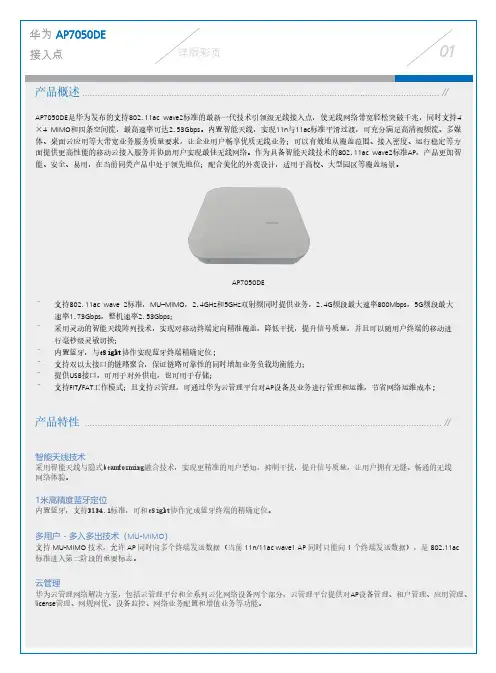
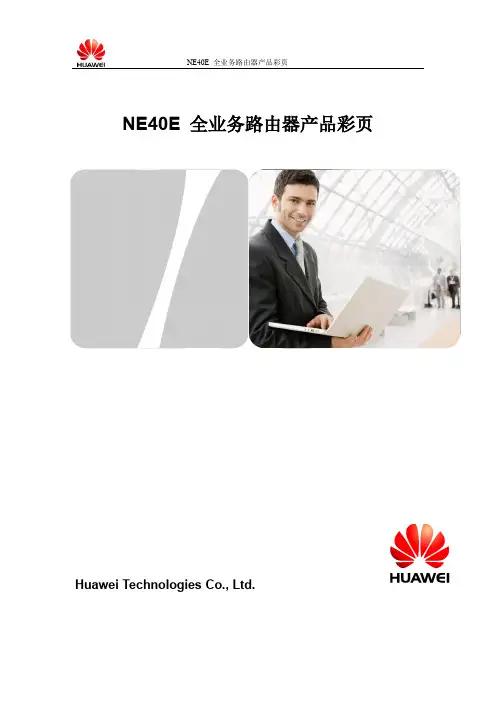
NE40E 全业务路由器产品彩页Huawei Technologies Co., Ltd.NE40E 全业务路由器产品彩页产品概述NetEngine40E 系列全业务路由器(以下简称 NE40E )是华为公司推出的高端网络产品,主要应用在企业广域网核心节点、大型企业接入节点、园区互联&汇聚节点以及其他各种大型IDC 网络的边缘位置,与NE5000E 骨干路由器、NE20E 汇聚路由器产品配合组网,形成结构完整、层次清晰的IP 网络解决方案。
NE40E 采用华为自研Solar 系列NP 芯片,基于CLOS 分布式多级交换架构,采用分布式的硬件转发和无阻塞交换技术,具有良好的线速转发性能,优异的扩展能力,完善的QoS 机制和强大的业务处理能力。
NE40E 基于最新的可扩展2T 平台,每槽位最大提供1T 路由线卡,兼容现网线卡,最大限度保护客户的投资。
NE40E 具有强大的汇聚接入能力,凭借丰富的特性支持,可以灵活部署L2VPN 、L3VPN 、组播、组播VPN 、MPLS TE 、QoS 等,实现用户业务的可靠承载;支持丰富的增值业务特性,如GRE 隧道、IPSec 安全隧道NetStream 等;同时,NE40E 全面支持IPv6,可以实现IPv4到IPv6的平滑过渡。
因此,NE40E 可以灵活应用在IP/MPLS 网络的边缘、核心,可以简化网络结构,提供丰富的业务类型和可靠的服务质量,是IP/MPLS 承载网向宽带化、安全化、业务化、智能化发展的重要源动力。
外观NE40E 系列主要包括NE40E-X16A/X16, NE40E-X8A/X8,NE40E-X3/X3A 适应不同规模的网络组网需求。
NE40E X16A NE40E-X16NE40E-X8ANE40E-X8NE40E-X3ANE40E-X3产品特点领先的2T 平台NE40E系列节能减排机框基于2T平台,每槽位最大可以平滑扩容到2Tbps带宽,实现大容量业务承载,满足未来带宽增长需求。
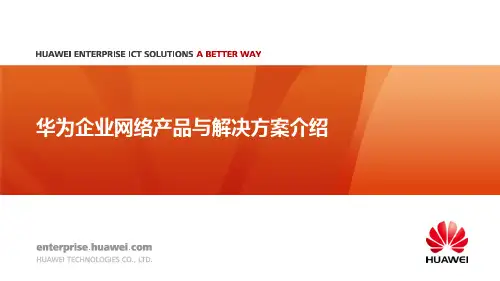
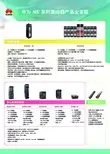
小型企业正面临许多需要持续关注的挑战,所以网络部署和运行网络不应成为额外的难题。
为企业选择最好的 Wi-Fi 会让您的工作生活更加轻松。
我们把为 Wi-Fi 用户提供满意的服务,将移动设备连接入网,并保证网络的安全变成了一件非常容易的事情。
不费吹灰之力即可轻松构建员工和访客网络。
智能 Mesh Wi-Fi 可以轻松覆盖每个房间,无需布线。
带宽滥用和网络上的未知设备已经成为过去。
现如今,无论是小型的零售店,还是繁忙的家庭旅馆,Wi-Fi 都扮演着非常重要的角色。
Aruba Instant On 接入点 (AP) 易于部署和管理,价格诱人。
从安装附件到易于使用的网页管理界面,再到移动应用管理工具,以及企业级的软件功能——这所有的一切都包含在内,无需额外收费或者部署外部控制器。
超快 802.11ac Wave 2, 2X2:2 MU-MIMO 性能智能 Mesh Wi-Fi 支持内置 WiFi 路由器/网关功能内容和终端访问控制简单易用的高级用户带宽优化功能易于使用的网络和移动应用程序,用于设置和管理通过简单设置保护访客 Wi-Fi应用程序识别、控制和可见性PPPoE 和静态 IP保持简单的同时实现最佳性能开箱即用的 Wi-Fi让用户满意的性能我们提供您所需的一切没有额外的许可费行业领先的质保和支持值得托付的安全性使用双重身份验证防止登录凭据被盗用面向未来的 WPA2/WPA3/OWE 安全 Wi-Fi接入认证亮点内置安全网关/防火墙阻止来自外部的人员和机器人接入网络对小企业至关重要。
我们内置了高级功能,不需要单独部署外部网关,因此也不会带来组网的复杂性。
在网关出现故障的情况下,只需轻点鼠标即可简单快速地将网关切换到另一个AP。
应用程序可见性和控制完整查看网络上运行的应用程序,还具备阻止某些应用程序使用的能力。
您也可以灵活地在Instant On 移动应用程序中关闭此功能。
方便访客接入用图标、身份认证、使用规则或保持简单来实现个性化体验。
MA5683T MA5680T MA5608TRS485集中器电表MA5633MA5631MA5632CMEOC 终端MA5621MA5621AMA5620MA5626MA5669MA5612MA5616· 完备的 Qos 功能,支持流分类管理,优先级控制,带宽控制。
H-QoS 功能满足多样化商业客户的SLA 要求· 端到端高可靠设计,上行支持BFD/Smart Link/LACP 冗余保护,支持EPON TypeB/TypeD 和GPON Type B/Type C 线路保护多场景接入· 多种E1专线接入,支持Native TDM 或CESoP/SAToP 功能· 支持E-LAN 功能,实现基于VLAN 内部流量互通,满足企业及园区组网应用· 支持IPTV 用户无收敛接入,单框支持8000组播用户和4000组播频道平滑演进· EPON/GPON/10G PON/40G PON 共平台,支持平滑演进,满足超宽带接入。
· 支持IPv4/IPv6双栈,支持IPv6组播,实现IPv4向IPv6的平滑演进绿色节能· 独有芯片技术,高密度16端口GPON 单板功耗不超过73瓦· 支持空闲单板自动下电,风扇智能调速,有效降低闲时功耗。
产品外观汇聚接入一体· 超高汇聚交换能力,3.2T 背板容量,1920G 交换容量,512K MAC 地址容量· 超高密度级联能力,最大支持44路10 GE 或 768个GE 接入,无需额外投资汇聚交换机 高可靠性· 高可靠组网能力,支持OLT 双机热备份、异地容灾、升级业务不中断关键特点SmartAX MA5680T 系列产品MA5680T MA5683T MA5608T华为MA5680T 系列OLT 基于华为第三代统一平台开发,融合汇聚交换功能,可提供高密度的xPON 、GE/10GE 接口。
NE20E-S具有强大的业务承载能力,根据组网需求可以同时部署L2VPN、L3VPN、MVPN,支持和TE (Traffic Engineering)同时部署,支持灵活QinQ,支持DHCP,还可提供Netstream等功能,适应传统的接入需求和新兴的业务需求,满足多业务融合丰富的承载需求。
NE20E-S具有强大的可扩展组播能力,支持丰富的IPv4/IPv6组播协议,包括PIM-SM/SSM、MLDv1/v2、IGMPv3、IGMPSnooping等特性,可以灵活承载IPTV等视频业务,可以满足各种规模的组播业务的需求。
全方位的可靠性解决方案NE20E-S系列路由器采用分布式处理架构,主控、交换和转发物理分离,控制平面和业务平面分离,确保业务和控制互不干扰,主备倒换时不影响业务转发。
NE20E-S从多个层面提供可靠性保护,包括设备级、网络级、业务级可靠性,形成了面向整个网络的解决方案,完全满足电信级的可靠性需求,是构筑电信级业务的基石,达到99.999%的系统可用性。
设备级可靠:NE20E-S提供关键部件的冗余备份。
关键组件支持热插拔与热备份、NSR(Non-Stop Routing)、NSF(Non-Stop Forwarding)和ISSU等技术一起保障无中断业务运行。
网络级可靠:NE20E-S提供IP/LDP/VPN/TE快速重路由,Hot-Standby,IGP、BGP以及组播路由快速收敛,虚拟路由冗余协议(VRRP,Virtual Router Redundancy Protocol),TRUNK链路分担备份,硬件BFD链路3.3ms快速检测,MPLS/Ethernet OAM,保证整网稳定性,可以提供端到端200ms保护倒换,业务无中断。
业务级可靠:NE20E-S提供的VPN FRR和E-VRRP技术,VLL FRR和Ethernet OAM技术以及PW Redundancy,可以应用于L3VPN和L2VPN组网方案中,保证业务层面的冗余备份,使业务稳定可靠不中断。
华为
接入点详版彩页
............................................................................................................................................ //
10
AP2050DN-E天线方向性图
5G (PHI=0) 5G (PHI=90)
版权所有© 华为技术有限公司2017。
保留一切权利。
非经本公司书面许可,任何单位和个人不得擅自摘抄、复制本文档内容的部分或全部,并不得以任何形式传播。
商标声明
和其他华为商标均为华为技术有限公司的商标。
本文档提及的其他所有商标或注册商标,由各自的所有人拥有。
免责声明
本文档可能含有预测信息,包括但不限千有关未来的财务、运营、产品系列、新技术等信息。
由于实践中存在很多不确定因素,可能导致实际结果与预测信患有很大的差别。
因此,本文档信息仅供参考,不构成任何要约或承诺。
华为可能不经通知修改上述信息,恕不另行通知。
华为技术有限公司深圳市龙岗区坂田华为基地
邮编:518129电话: +8675528780808
www.huawei.
com。